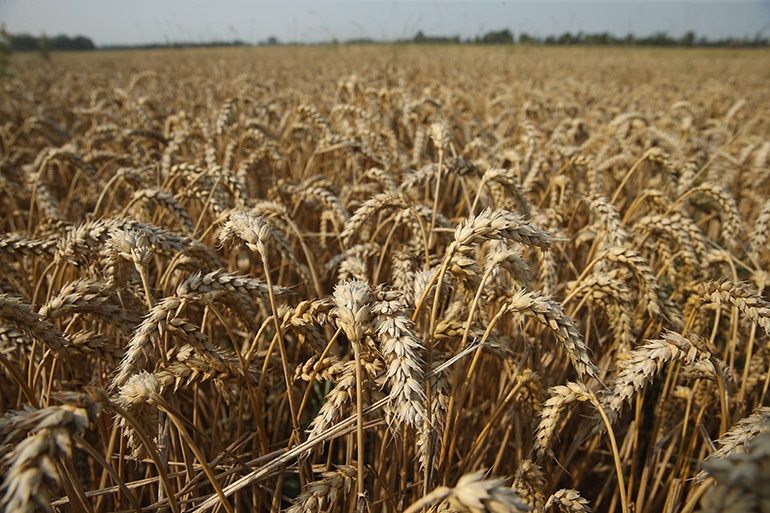Red dog has more nutritional value than wheat middlings for pigs
Wheat middlings contains more fiber but less starch than red dog, and the concentration of lysine is much greater in red dog than in wheat middlings.
August 31, 2017

By Hans H. Stein, Jennifer Roth and Gloria A. Casas, University of Illinois
Wheat middlings and red dog are coproducts of the wheat milling industry and these coproducts are often used as a source of energy and protein in animal feed. However, because wheat coproducts vary in terms of the conditions under which they are produced, their nutritional value may vary as well.
Despite being produced in the United States in relatively large quantities, there is limited information about the nutritional value of wheat middlings and red dog when fed to pigs. Therefore, two experiments were conducted to determine the digestibility of crude protein and amino acids and the concentration of digestible energy and metabolizable energy in 10 sources of wheat middlings and in one source of red dog.
Composition of ingredients
The 10 sources of wheat middlings were collected from flour mills located in the eastern part of the United States or in the Midwest and the one source of red dog was procured from a production facility in Iowa. The concentration of gross energy was slightly greater in wheat middlings (3,978 kilocalories per kilogram) compared with red dog (3,801 kilocalories per kilogram), but both ingredients contained approximately 17% CP (Table 1).

Table 1: Analyzed composition of the 10 sources of wheat middlings and red dog (as-fed basis)
However, the fiber components (ADF, NDF, lignin) were much greater in wheat middlings than in red dog, which reflects the different parts of the wheat kernel that are included in wheat middlings compared with the parts that are included in red dog. There was also a much greater concentration of starch in red dog than in wheat middlings, which further indicates the difference in the components included in the fractions in the two coproducts. The concentration of indispensable AA was consistent among the 10 sources of wheat middlings. Wheat middlings contained an average of 0.71% lysine and 0.26% methionine, compared with 0.63 and 0.37% in red dog.
Amino acid digestibility
The average standardized ileal digestibility of CP in wheat middlings was 58.5% (Table 2). There were no differences in SID of CP, histidine or methionine among the 10 sources of wheat middlings, but there were variations in the SID of all other indispensable AA. The SID of CP and all AA except arginine and histidine was, however, greater (P < 0.05) in red dog than in wheat middlings. The SID of lysine was 72.3% in red dog, but averaged only 46.2% in wheat middlings, suggesting that the wheat middlings may have been damaged by excessive heat during production.

Table 2: Standardized ileal digestibility of crude protein and amino acids in wheat middlings and red dog
Concentration of DE and ME and digestibility of energy and fiber
The mean apparent total tract digestibility for GE in the 10 sources of wheat middlings was 67.2% with only minor variations among sources (Table 3). The ATTD of NDF in wheat middlings ranged from 31.5 to 56.6%, with a mean of 40.7%. The ATTD of ADF ranged from 15.6 to 37.2%, with a mean of 28.0%.

Table 3: Apparent total tract digestibility of gross energy, NDF and ADF, and concentration of DE and ME in the 10 sources of wheat middlings and red dog
The concentration of DE in wheat middlings ranged from 2,352 to 2,844 kilocalories per kilogram on an as-fed basis (mean: 2,653 kilocalories per kilogram) and from 2,637 to 3,185 kilocalories per kilogram on a dry matter basis (mean: 2,990 kilocalories per kilogram). Metabolizable energy ranged from 2,272 to 2,751 kilocalories per kilogram as fed (mean: 2,568 kilocalories per kilogram) and from 2,546 to 3,125 kilocalories per kilogram dry matter (mean: 2,893 kilocalories per kilogram). The mean ATTD values of GE was less (P < 0.005) than the values for red dog, but the mean ATTD of NDF was greater (P < 0.001) in wheat middlings than in red dog. Red dog contained 3,058 kilocalories per kilogram DE and 2,952 kilocalories per kilogram ME on an as-fed basis, and 3,418 kilocalories per kilogram DE and 3,300 kilocalories per kilogram ME on a dry matter basis and the DE and ME in red dog were greater (P < 0.001) than the mean values for wheat middlings.
You May Also Like



